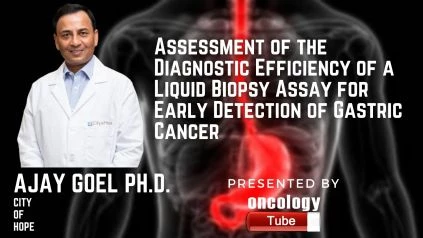Ajay Goel, Ph.D., AGAF, chair of City of Hope’s Department of Molecular Diagnostics and Experimental Therapeutics speaks about Assessment of the Diagnostic Efficiency of a Liquid Biopsy Assay for Early Detection of Gastric Cancer.
Link to Abstract:
https://pubmed.ncbi.nlm.nih.gov/34427680/
Summary –
Significance:
Noninvasive early-stage disease diagnosis is an important method for lowering gastric cancer (GC)-related patient death.
Goal:
Using a thorough biomarker discovery strategy with retrospective and prospective validation, create a new, noninvasive microRNA (miRNA)-based signature for the early identification of GC.
Participants, environment, and layout:
This diagnostic investigation was carried out in four steps, utilizing publicly accessible genome sequences and tissue samples from patients at a Japanese university medical facility, and was verified with retrospective multicenter cohorts of GC patients. Three tissue miRNA data sets were utilized to create a miRNA signature that could tell the difference between GC and normal tissues. This signature’s robustness was tested in serum from two retrospective cohorts of GC patients. After developing a risk-scoring model, the performance of the miRNA signature was tested in a prospective cohort of GC patients. The miRNA signature’s robustness was compared to conventional blood-based indicators, as well as a cost-effectiveness study of the miRNA signature against the current endoscopic practice. Between April 1997 and March 2018, all clinical samples for this research were collected and data evaluated.
Main results and metrics:
The area under the curve (AUC), specificity, and sensitivity are used to evaluate diagnostic efficiency.
Outcomes:
There were 598 total patient samples in the data sets for the genome-wide expression profiling analysis stage (284 [55.4 percent ] from men; mean [SE] patient age, 65.7 [0.5] years). The resulting 10-miRNA signature was validated in two retrospective GC serum cohorts (586 patients; 348 [59.4 percent] men, mean [SE] age, 66.0 [0.7] years), resulting in the establishment of a 5-miRNA signature (AUC, 0.90; 95 percent CI, 0.85-0.94) with high diagnostic performance in stage I disease patients (AUC, 0.89; 95 percent CI, 0.83-0.94). The test was refined to a small number of miRNAs using a risk-scoring algorithm. The effectiveness of the resultant 3-miRNA signature was subsequently confirmed in a prospective cohort of GC patients (349 patients; 124 [70.5 percent ] men, median [range] age, 66.0 [0.66] years). The final three-miRNA signature (miR-18a, miR-181b, and miR-335) had good diagnostic accuracy in all stages of patients (AUC, 0.86; 95 percent CI 0.83-0.90), including stage I illness patients (AUC, 0.85; 95 percent CI, 0.79-0.91). Furthermore, in a cost-effectiveness study, this miRNA signature beat presently utilized blood indicators and endoscopic screening (incremental cost-effectiveness ratio, CNY 16162.5 per quality-adjusted life-year [USD $2304.80 per quality-adjusted life-year]).
Conclusions and applicability:
These findings point to the 3-miRNA signature’s potential clinical use as a noninvasive, cost-effective, and simple test for the early identification of GC.

